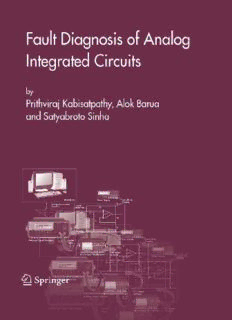Table Of ContentFAULTDIAGNOSIS OF ANALOG INTEGRATED CIRCUITS
FAULT DIAGNOSIS OF ANALOG
INTEGRATED CIRCUITS
by
PRITHVIRAJ KABISATPATHY
Biju Patnaik University of Technology,
Bhubaneswar, India
ALOK BARUA
Indian Institute of Technology,
Kharagpur, India
and
SATYABROTO SINHA
Indian Institute of Technology,
Kharagpur, India
AC.I.P. Catalogue record for this book is available from the Library of Congress.
ISBN-10 0-387-25742-X (HB)
ISBN-13 978-0-387-25742-6 (HB)
ISBN-10 0-387-25743-8(e-book)
ISBN-13 978-0-387-25743-3(e-book)
Published by Springer,
P.O. Box 17, 3300 AADordrecht, The Netherlands.
www.springeronline.com
Printed on acid-free paper
All Rights Reserved
© 2005 Springer
No part of this work may be reproduced, stored in a retrieval system, or transmitted
in any form or by any means, electronic, mechanical, photocopying, microfilming, recording
or otherwise, without written permission from the Publisher, with the exception
of any material supplied specifically for the purpose of being entered
and executed on a computer system, for exclusive use by the purchaser of the work.
Printed in the Netherlands.
Dedication
Toourwives
Indrani,
Mausumi
and Gita
Toourchildren
Priyasha,
Arpita,
Santanu and Sandipan
Contents
Dedication v
Preface 1
Chapter 1 INTRODUCTION 3
1.1 Basic Concepts 4
1.2 Historical Background 8
1.3 Summary 15
References 16
Chapter 2 FAULT AND FAULT MODELLING 23
2.1 Introduction 23
2.2 Failure modes in electronic components 25
2.3 Analog fault modelling 27
2.4 Approximation modelling of analog integrated circuits 31
2.5 Summary 35
vv iiiiii Contents
Exercises 35
References 37
Chapter 3 TEST STIMULUS GENERATION 41
3.1 Introduction 41
3.2 Conventional analog test stimulus generation 44
3.3 Digital test stimulus generation 49
3.4 Delta sigma ((cid:507)-(cid:520)) signal generation 53
3.5 Pseudorandom noise generation 60
3.6 Summary 67
Exercises 68
References 69
Chapter 4 FAULT DIAGNOSIS METHODOLOGY 73
4.1 Introduction 73
4.2 Fault diagnosis procedure 74
4.3 Fault dictionary techniques 75
4.4 DSP based techniques 79
4.5 Model based observer technique 82
4.6 Experimental verification of the model based
observer technique 122
4.7 Summary 130
Exercises 130
References 131
Contents ix
Chapter 5 DESIGN FOR TESTABILITY AND
BUILT-IN-SELF-TEST 133
5.1 Introduction 133
5.2 Design-for-testability approaches 136
5.3 Increased testability with test bus 142
5.4 Built-in-self-test 145
5.5 Summary 149
References 149
Appendix A 153
Appendix B 159
Appendix C 169
Notes 177
Index 179
Preface
The field of integrated circuit has undergone remarkable changes over
the past decade. Integrated circuits incorporating both digital and analog
function have become more and more popular in semiconductor industry.
These combined circuits are called “Mixed Signal Circuits”. Fault diagnosis
and testing of integrated circuit has grown into a special field of interest in
semiconductor industry. The methodologies for testing of digital circuits are
well established. However the methodologies for fault diagnosis of analog
integrated circuits are relatively unexplored. Some of the reasons for this
under development are lack of proper fault model of the devices operating in
the continuous time domain, multiple value of the signal at each node of the
circuit, etc.
This book, Fault Diagnosis of Analog Integrated Circuits, is primarily
intended as a comprehensive text book at the graduate level, as well as a
reference book for practicing engineers in the area of analog integrated
circuit testing. Unlike other books, this book does not assume any solid
background in analog circuits. A working knowledge of PSpice and
MATLAB is necessary. An exposure to artificial neural network (ANN) is
desirable.
The prime objective of the book is to provide insight into the different
fault diagnosis techniques of analog integrated circuits.
The text is divided into five chapters. Chapter 1 presents an introduction
to the basic concepts of fault diagnosis. Both simulation-after-test and
simulation-before-test, have been discussed. Fault modelling is presented in
Chapter 2. The choice of optimum test stimulus is the key to success in fault
diagnosis. All classical and state of the art techniques of test stimulus
generation have been discussed in Chapter 3. Chapter 4 presents a feasible
1
2 fffault diagnosis of analog integrated circuits
fault diagnosis methodology. The state of the art model based observer
technique, is discussed in detail. The integrated circuit, particularly the
operational amplifier is the most used building block of analog signal
processing. This chapter presents a detailed overview of fault diagnosis of
operational amplifiers (at the device or component level) using model based
observer technique. Simulation results for the fault in bipolar and MOS
operational amplifiers are given here. Besides, fault diagnosis of simple
analog system-on-chip (SOC) is also presented. An experimental setup for
fault detection and diagnosis in analog ICs and SOCs, is also presented in
Chapter 4. Chapter 5 rounds off the text with Design-for-test (DfT)
techniques and development of Built-in Self-test (BIST) facilities in analog
ICs.
The problems at the end of the chapters 2, 3 and 4 may be assigned to the
students forwork out.
Three appendices present BJT spice parameter values of the µA 741
operational amplifier, MOSFET spice parameter values of the MOS
operational amplifier and anintroduction to artificial neural network (ANN).
Although an immense effort and attention to detail were exerted to
prepare the manuscript, the book may still have some errors due to human
nature. The authors welcome suggestions from the readers for improvement
of the content and the presentation, for future incorporation.
We take this opportunity to express our appreciation to our numerous
students and colleagues whose ideas and suggestions lead to this book. We
would also like to acknowledge the support extended by our families; in
particular we are grateful to our wives and children for tolerating many
absences while we spent hours on this book.
February, 2005 P. Kabisatpathy
Kharagpur A. Barua
S.Sinha
Description:Enables the reader to test an analog circuit that is implemented either in bipolar or MOS technology. Examines the testing and fault diagnosis of analog and analog part of mixed signal circuits. Covers the testing and fault diagnosis of both bipolar and Metal Oxide Semiconductor (MOS) circuits and

